Acoustic guitar pedals are often overlooked in comparison to their electric guitar equivalents. Over the years I’ve tested dozens of them, and in this article, I’ll be sharing my favorites at each price point.
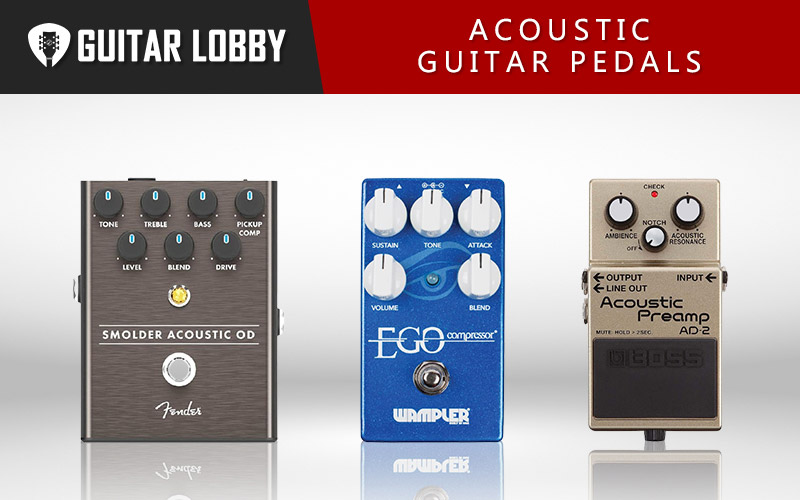
The list is broken down into effects categories, and there are options to suit all playing styles and budgets. Let’s get started and take a look at the best acoustic guitar pedals on the market right now!
| Name of Product | Image of Product | Description | Price Range | Full Review |
|---|---|---|---|---|
| 1. BOSS WAZA Craft (CE-2W) | 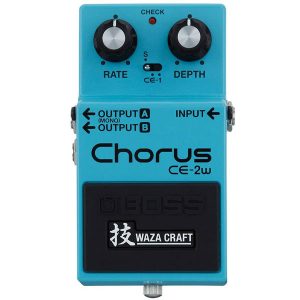 | Type: Analog Effects: Chorus | $200 | Read Full Review Below |
| 2. Deadbeat Sound Wet Dreams | 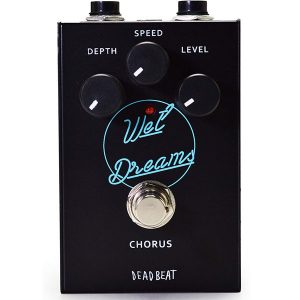 | Type: Analog Effects: Chorus | $75 | Read Full Review Below |
| 3. L.R Baggs Align Acoustic Reverb | 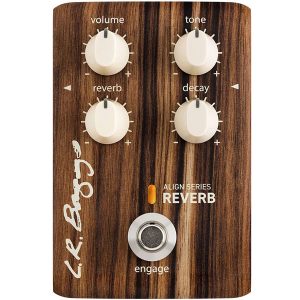 | Type: Analog Effects: Reverb | $180 | Read Full Review Below |
| 4. Caline Wonderland | 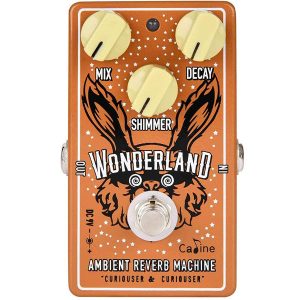 | Type: Analog Effects: Reverb | $70 | Read Full Review Below |
| 5. L.R Baggs Align Acoustic Delay | 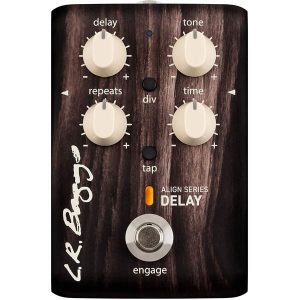 | Type: Analog Effects: Delay | $180 | Read Full Review Below |
| 6. Flamma FS03 | 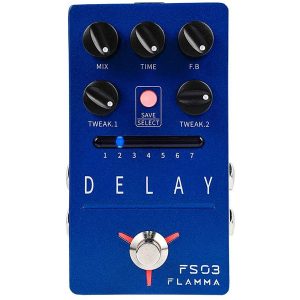 | Type: Analog Effects: Delay | $70 | Read Full Review Below |
| 7. Wampler Ego | 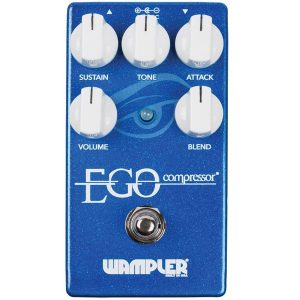 | Type: Analog Effects: Compression | $200 | Read Full Review Below |
| 8. Mooer Yellow Comp | 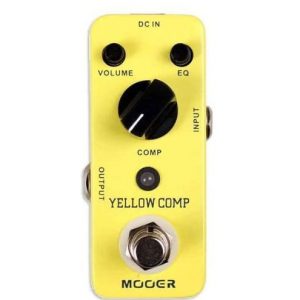 | Type: Analog Effects: Compression | $70 | Read Full Review Below |
| 9. Fender Smolder | 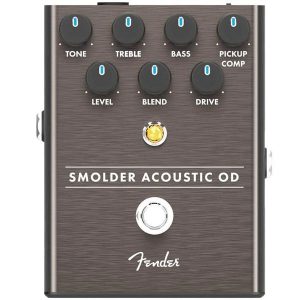 | Type: Digital Effects: Overdrive | $150 | Read Full Review Below |
| 10. TC Electronic MojoMojo | 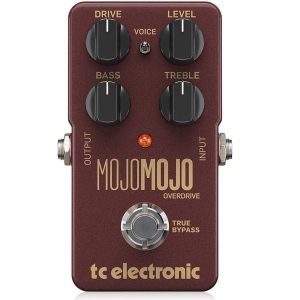 | Type: Digital Effects: Overdrive | $60 | Read Full Review Below |
| 11. NUX Stageman | 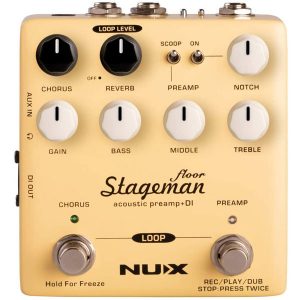 | Type: Digital Effects: Preamp | $150 | Read Full Review Below |
| 12. BOSS AD-2 | 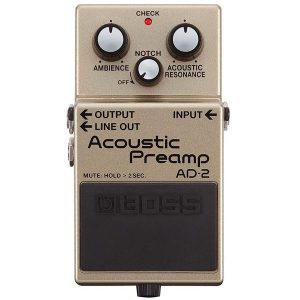 | Type: Digital Effects: Preamp | $100 | Read Full Review Below |
| 13. L.R Baggs Align Acoustic Equalizer | 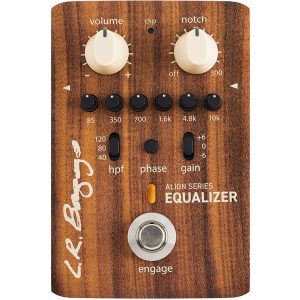 | Type: Digital Effects: EQ | $180 | Read Full Review Below |
| 14. JOYO R-12 | 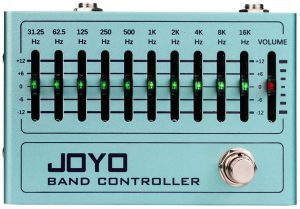 | Type: Analog Effects: Chorus | $90 | Read Full Review Below |
| 15. Zoom A1 Four | 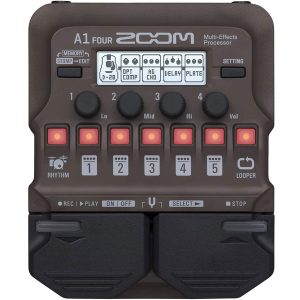 | Type: Digital Effects: Looper | $130 | Read Full Review Below |
| 16. ISET Looper Pro | 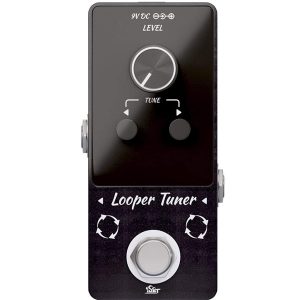 | Type: Analog Effects: Looper | $50 | Read Full Review Below |
| 17. BOSS ME-80 | 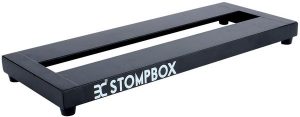 | Type: Digital Effects: Multi-FX | $300 | Read Full Review Below |
Here Are the Best Acoustic Guitar Pedals
1. BOSS WAZA Craft CE-2W (Chorus Pedal)
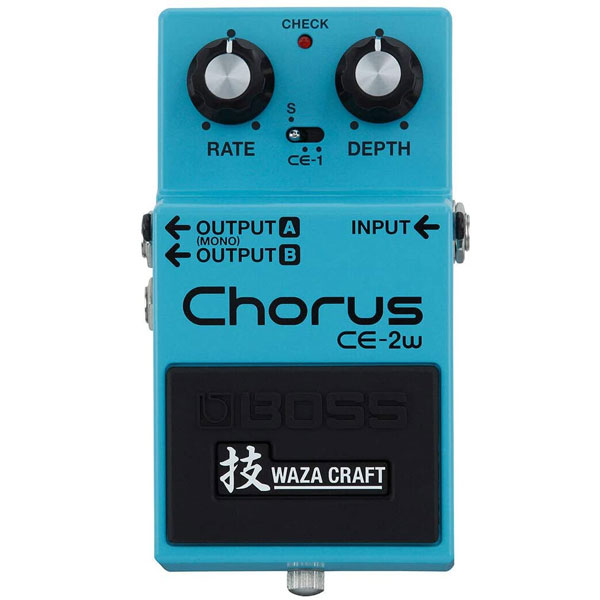
| Estimated Price | $200 |
| Type | Analog |
| Effects | Chorus |
| Connectivity | 1 x 6.35mm Jack Input, 2 x Outputs |
| Power | 9 Volt |
My Review: Boasting an incredibly extensive range of stompboxes, iconic guitar pedal manufacturers BOSS has been setting the standard for decades. Many of their pedals are built upon the success of their early models, but one thing’s for sure, BOSS is always looking for ways to improve their effects.
In my experience, WAZA Craft chorus pedals are perfectly suited for the natural timbre of an acoustic guitar. I was pleased to find that by recreating the classic sound of its predecessors, the CE-1 and the CE-2, the CE-2W houses several new features which propel it to new sonic heights.
Right after plugging my acoustic guitar into the WAZA Craft, I was able to choose between the standard CE-2 chorus sound or the vintage tones of the original model. There’s also a switch for engaging the smooth vibrato effects that are also housed within this analog acoustic guitar pedal.
The CE-2W sounds fantastic when used with either electric or acoustic guitar. Chorus is one of the least invasives of modulation effects, and therefore I was still able to allow the natural sound of the acoustic guitar to be prominent in the mix while adding coloration and character using the onboard parameters on this premium BOSS stompbox.
If I had to choose a particular feature of the CE-2W Waza Craft which sets it apart from other similar pedals, I’d find that very difficult! There’s simply so much to cover with this BOSS pedal. I really liked how they improved the range of sounds it houses, offering several presets that aren’t available with the original version. The two stereo sound modes and variable depth control have improved the functionality of the Waza Craft significantly.
Who is this best suited for: Chorus pedals go hand in hand with an acoustic guitar. Regardless of your playing style, or the main genres that your music falls into, you’ll benefit from the array of sweet-sounding overtones that the WAZA Craft pedal brings to the table. It’s especially useful for those who enjoy composing lo-fi hip-hop-style guitar riffs and licks.
Bottom Line: BOSS design their pedals meticulously, drawing from the decades of experience they have in the field of effects. The WAZA Craft CE-2W benefits from the knowledge gained as a result of its two predecessor pedals. With newly added options and improved overall sound, the WAZA Craft is a great addition for any acoustic guitarist.
2. Deadbeat Sound Wet Dreams (Chorus Pedal)
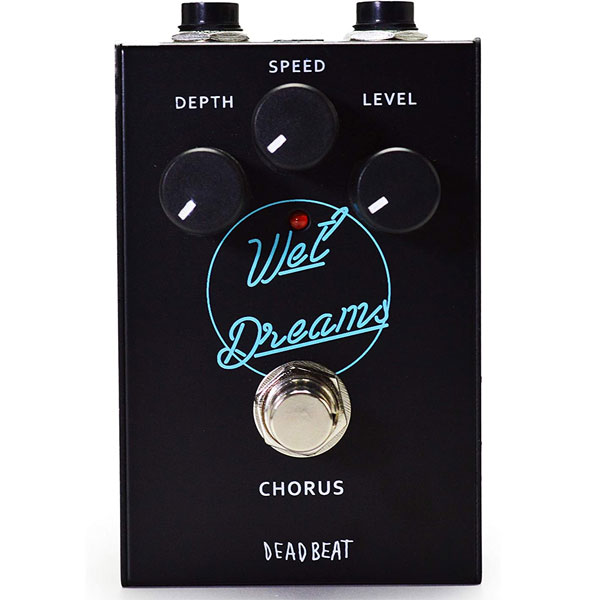
| Estimated Price | $75 |
| Type | Analog |
| Effects | Chorus |
| Connectivity | 1 x 6.35mm Jack Input, 1 x Outputs |
| Power | 9 Volt |
My Review: We set out to find an affordable chorus pedal to use with an acoustic guitar, and found the Wet Dreams by Deadbeat Sound to be highly recommendable. I particularly liked that this analog chorus pedal is designed in a minimalistic fashion, with three rotary controls installed across the top half and a classic footswitch on the bottom.
Based on our findings, the main reason that this pedal works so well with acoustic guitar is its ability to deliver a clean-sounding chorus that interacts smoothly with the high-end harmonics and the rich low-end of the instrument. The three parameters, which consist of depth, speed, and level, provide guitarists with the platform to sculpt the chorus tone to suit any style of acoustic guitar playing.
I was impressed with the fact that by adjusting the depth control, I could affect the overall tone of the chorus. When this is turned up, the pedal produces a fluctuating, hectic warble with noticeable detuning in places. Alternatively, I found that by keeping that setting low I could enjoy subtle modulating overtones. The speed control affects the pace of the fluctuations, and again can be used in an understated manner or for more extreme results.
By installing true bypass switching, Deadbeat Sound has ensured that the acoustic guitar’s clean tone won’t be compromised when the Wet Dreams chorus pedal is inactive. I liked the fact that this pedal also comes with a power supply, which provides 9 volts DC. You can also use a single 9-volt battery to power the pedal if you wish.
The standout qualities of the Wet Dreams acoustic guitar chorus pedal are as follows: firstly, it’s incredibly affordable for the high standard of tones it produces. Secondly, the simplistic design may make the pedal’s capabilities seem limited, by I found that there’s plenty of room for sculpting original tones using the three-knob layout. The true bypass switching is great, but if there’s one thing I found this pedal to be lacking, it’s an additional output for signal-splitting.
Who is this best suited for: If a chorus pedal is at the top of your wish list but you’d rather save a little money to purchase other acoustic guitar effects too, the Wet Dream by Deadbeat Sound is a great option. In terms of quality, it rivals the more expensive chorus pedals on the market, providing a wide range of modulated tones to add to your sonic arsenal.
Bottom Line: Deadbeat Sound is a relatively newly established manufacturer of effects pedals, which makes their rise to prominence impressive. This chorus pedal is one of their finest offerings, and it sounds equally as great when used with an acoustic guitar as it does when used with an electric model. The three controls give you complete freedom over the nature of the effect, and allow you to sculpt the chorus to suit your requirements.
3. L.R Baggs Align (Reverb Pedal)
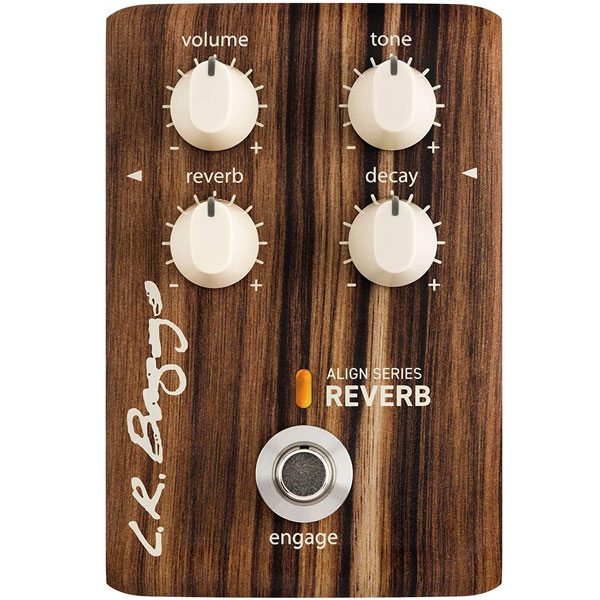
| Estimated Price | $180 |
| Type | Analog |
| Effects | Reverb |
| Connectivity | 1 x 6.35mm Jack Input, 1 x Outputs |
| Power | 9 Volt |
My Review: Before analyzing this device we were aware that the Align series by L.R Baggs includes some of the finest pedals specifically designed for acoustic guitar. As we expected, this particular reverb offering produces a plethora of stunning textures to soften the tone of your instrument.
Designed to complement the natural dynamics and warm tone of acoustic instruments, the Align Reverb pedal features sophisticated analog circuitry which combines the wet and dry signal intuitively. Right off the bat, we were impressed with the way this results in a luscious blend of natural acoustic tone, and space-enhancing reverbs.
L.R Baggs shaped this reverb pedal with analog EQ. This allowed them to reflect the natural reverbs that are produced when sound waves from the strings come into contact with the tonewoods of an acoustic guitar. The tone control allows guitarists to adjust the color of the reverb to suit the specifics of our instrument.
First impressions are everything when it comes to acoustic guitar pedals. The Reverb from the Align series instantly stands out amongst the crowd. I liked how the manufacturer used their experience from the other pedals in the series to enhance the functionality and performance of the Reverb edition. Like all L.R Baggs pedals, I found it to sound incredibly natural and organic, compared to other pedals that sound more artificial and processed.
Who is this best suited for: If reverb is at the top of your acoustic guitar pedal wishlist, you won’t find it much better than the Align by L.R Baggs. Part of their revered acoustic-focused series, this reverb pedal is compatible with all styles of playing.
Bottom Line: The Align Reverb by L.R Baggs is a wonderful pedal to use with an acoustic guitar. It was designed to interact fluidly with the natural properties of an acoustic instrument and includes high-quality, analog circuitry. It’s also surprisingly versatile and can be used to create a wide range of reverberating tones.
4. Caline Wonderland (Reverb Pedal)
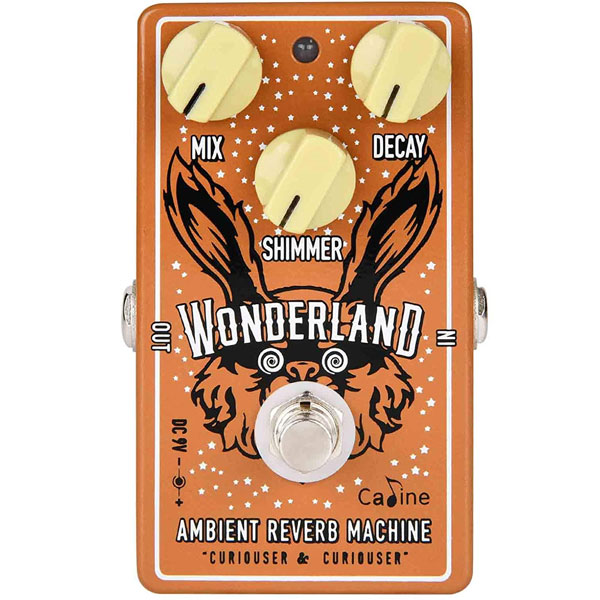
| Estimated Price | $70 |
| Type | Analog |
| Effects | Reverb |
| Connectivity | 1 x 6.35mm Jack Input, 1 x Outputs |
| Power | 9 Volt |
My Review: When I first encounter Wonderland by Caline, I noticed that it is described by the manufacturer as being an “ambient reverb machine”. I was impressed to discover that this is a statement that is backed up by its impact on an acoustic guitar’s tone. With a trio of rotary controls which are labeled mix, decay, and shimmer, it soon became clear that there’s plenty of space for adjustment.
The Wonderland has an eccentric design and an equally interesting sound. I found its functionality to be unique because it can be used to add shimmer to the acoustic guitar or to create washes of texture with practically limitless decay. One of the first things that stood out is how perfect this product is for experimental ambient styles of playing.
Some other features which caught my eye are the chassis of this Caline reverb pedal, which is made from durable aluminum alloy, and the fact that it also boasts true bypass switching. Furthermore, I liked the addition of the small LED indicator installed at the very top of the pedal which signifies clearly when the pedal is on or off.
As a fan of prog rock and shoegaze, I found the shimmering modulated reverb of the Wonderland pedal to be unique and intriguing. Compared to other acoustic guitar reverb pedals, this product focuses on textural and ambient tones, and I loved the fact you can use it to mess with the listener’s mind! As far as psychedelic reverb pedals go, this is up there with the best.
Who is this best suited for: If you enjoy playing ambient styles of music on your acoustic guitar, you’ll love the dreamy textures housed within the Calin Wonderland pedal. Ideal for creating psychedelic soundscapes, the pedal is versatile and immersive.
Bottom Line: The Caline Wonderland reverb pedal rivals more expansive models despite its modest price tag. With high-quality shimmering reverb that is suited to a range of styles, it’s a worthy addition to your pedalboard. The three rotary controls provide you with the freedom to customize the pedal’s sound to suit the acoustics of your instrument and the style of your playing.
5. L.R Baggs Align (Delay Pedal)
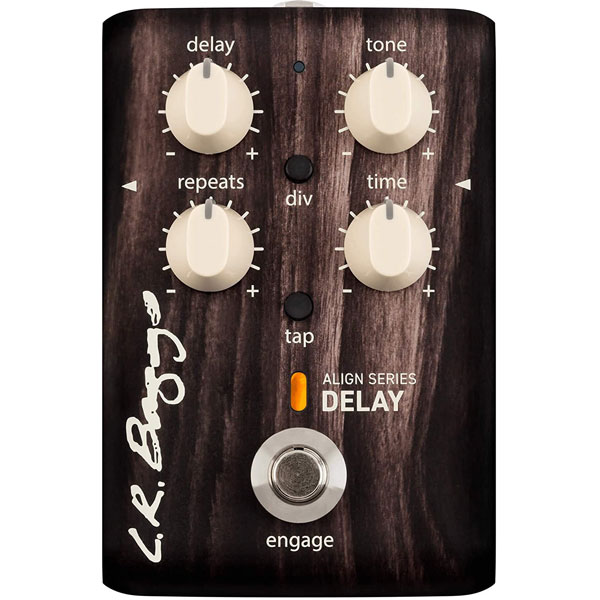
| Estimated Price | $180 |
| Type | Analog |
| Effects | Delay |
| Connectivity | 1 x 6.35mm Jack Input, 1 x Outputs |
| Power | 9 Volt |
My Review: In addition to their exceptional Align Reverb pedal featured earlier in this list, I felt inclined to mention that L.R Baggs also produces a wonderful delay pedal as part of the same acoustic guitar series. Designed to interact seamlessly with the natural timbre and tone of an acoustic instrument, I found this delay pedal to be bursting with character.
Compared to other acoustic guitar pedals, by using pristine and complex circuitry, L.R Baggs has created a delay pedal that is both versatile and ear-friendly. It is based around the quartet of rotary controls positioned on the face of the pedal, which I found made it very easy to affect the delay, tone, repeats, and time.
Another feature I’m a big fan of is the useful tap tempo button located just above the footswitch and a division button for setting the delay time to dotted eight notes at a tempo of your choice. This wide range of controls provided me with complete dominion over the nature of the delay produced by the pedal, and how it interacts with the amplified tone of an acoustic guitar.
Much like the reverb pedal from the same series, the Align Delay stands out as a classy option that oozes sophistication. It’s a very capable option for situations where the acoustic guitar’s clean tone is becoming a little repetitive. I loved the way array of delay tempos and timings that can be accessed with this L.R Baggs pedal, and although I’ll admit it’s more complex than other similar devices, the extra time spent familiarising myself with the controls was worthwhile!
Who is this best suited for: I’d highly recommend the L.R Baggs Align Delay pedal to any acoustic guitarist who enjoys adding complex rhythmic elements to their performances. This pedal allows you to be very precise with the delayed signals it produces, and therefore it’s a great choice for technically gifted players with great timing.
Bottom Line: Assembling a pedalboard for your acoustic guitar that simply consisted of the whole L.R Baggs Align series would provide you with pretty much everything you could need. This delay pedal offers rich, authentic tones, with the freedom to adjust almost every aspect of the effect.
6. Flamma FS03 (Delay Pedal)
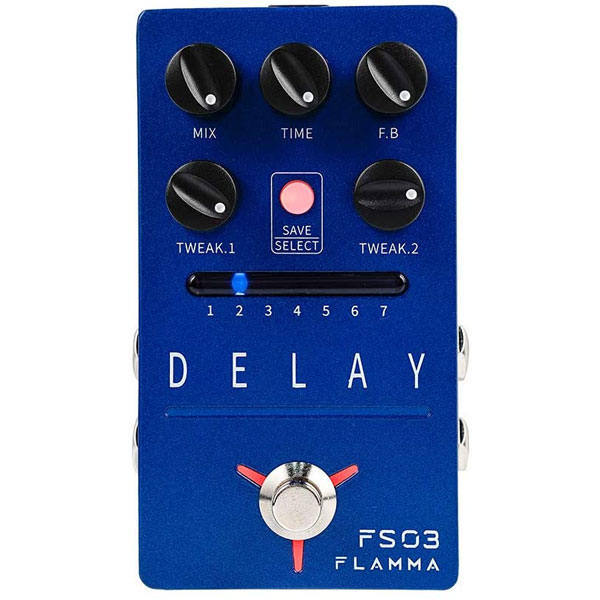
| Estimated Price | $70 |
| Type | Analog |
| Effects | Delay |
| Connectivity | 2 x 6.35mm Jack Input, 2 x Outputs |
| Power | 9 Volt |
My Review: Compared to similarly-priced and styled effects, I found that Flamma’s FS03 stereo delay pedal packs a considerably wide array of functions into a concise stompbox design. With classy, elegant aesthetics and easy-to-use controls, this delay pedal is ideal for acoustic guitarists like me, who want a simple way to add a sense of timing to their output.
Housed within the FS03 are six traditional stereo delay effects. These range from classic tight double tracking, to slapback style delay – which I am very fond of. Or, I found that by using the onboard controls to push the pedal to its limits, I was able to create layers upon layers of motioning tones.
The Flamma also includes an 80-second looper, which is great for solo acoustic guitar performances. Additionally, you can store any presets that you like to the pedal’s internal memory bank, and the tap tempo function is great for synchronizing the delay to the speed of a song or backing track.
For me, the first thing that stood out about the FS03 was its wide range of adjustable controls. Compared to other delay pedals in a similar price range, I found that this Flamma device was particularly extensive. Of course, there is a drawback to having more options on a delay pedal, and I’m aware that I could be confusing. However, figuring out how the looper and the various timing parameters interact with the acoustic guitar is a valuable learning curve.
Who is this best suited for: Affordable, reliable, and highly versatile, the Flamma FS03 would be a great addition to any acoustic guitarist’s pedalboard. It is capable of producing such a vast range of delay-draped tones, that it is suitable for almost all styles of acoustic guitar, from rhythmic strumming to technical fingerstyle playing.
Bottom Line: With a total of five delay presets based on classic effects, the FS03 provides you with the perfect platform for creating unique delayed tones. Once you’ve identified your preferred preset, you can then use the mix, time, feedback, and tweak controls to tailor each aspect of the pedal. Additionally, there’s a tap tempo and a save button for added convenience.
7. Wampler Ego (Compressor Pedal)
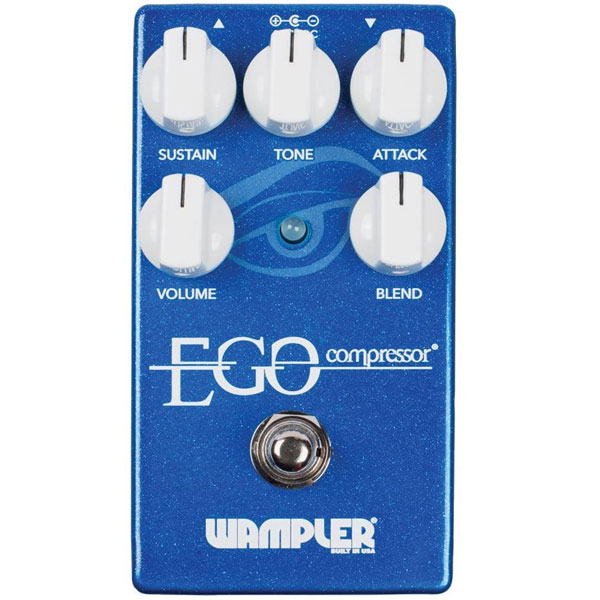
| Estimated Price | $200 |
| Type | Analog |
| Effects | Compression |
| Connectivity | 1 x 6.35mm Jack Input, 1 x Outputs |
| Power | 9 Volt |
My Review: Here at Guitar Lobby, we love compressor pedals. Ego is a truly exceptional compressor pedal by boutique effects manufacturers, Wampler. Although I was aware that this pedal was originally designed to be used with electric guitar, after doing some research I noticed that it has amassed a loyal fanbase of acoustic guitar players due to its unrivaled ability to tame the instrument’s dynamics.
It’s easy to think of compression as being a straightforward effect, that doesn’t vary from pedal to pedal. On the contrary, when I plugged into the Ego, it proved that compressors affect much more than just the dynamic range of an acoustic guitar.
With several onboard controls, I found that you can use the Wampler Ego compressor to set the tone for the rest of your acoustic guitar pedals. The blend control is particularly useful, facilitating a mixture of the wet and dry signals, and promoting a natural, acoustic tone.
When I first looked into the Ego compressor by Wampler, the thing that jumped out at me was its ability to control the dynamics of an acoustic guitar without coloring the tone. The clean blend feature facilitates this, and I think you’ll find it very useful if you’re already happy with the sound of your instrument and therefore would like to preserve it as much as possible.
Who is this best suited for: Acoustic guitarists who also sing while playing their instrument will love the dynamic consistency that the Wampler Ego facilitates. It prevents your acoustic guitar from being lost in the mix if you’re playing with other musicians and ensures that the output remains prominent at all times.
Bottom Line: Compressor pedals are often overlooked in terms of their importance, simply because they don’t produce the same level of transformative effects that other flashy guitar pedals do. Nevertheless, the Ego by Wampler proves that compressor pedals are one of the most vital components of any acoustic guitar rig. Not only does it provide you with dynamic control, but it also prevents any sudden audio spikes of feedback from wreaking havoc on your signal.
8. Mooer Yellow Comp (Compressor Pedal)
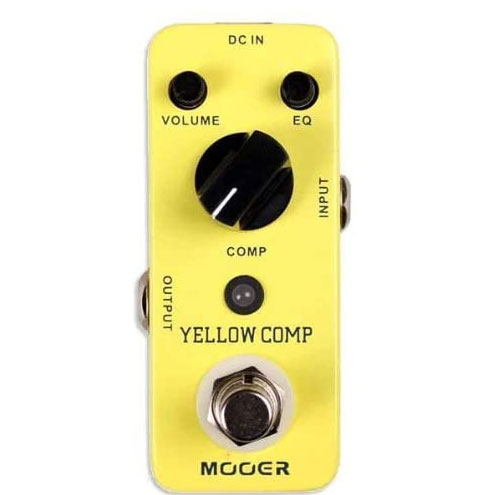
| Estimated Price | $70 |
| Type | Analog |
| Effects | Compression |
| Connectivity | 1 x 6.35mm Jack Input, 1 x Outputs |
| Power | 9 Volt |
My Review: The aptly named Yellow Comp by Mooer is a straightforward compressor pedal. After we tested it, we found it to be highly compatible with acoustic guitars. It produces classic, vintage-style optical compression, and I was really impressed with the functionality of its three rotary controls used to adjust the parameters.
In the top left corner, you have the volume control, which acts as the input level. To the right, there is an EQ control, which adjusts the coloration of the compressed tone, and I found that this was particularly useful when using heavy compression with an acoustic guitar along with other effects that alter its tone.
Overall I was impressed with the Mooer compressor, although I felt a little disappointed that it does not feature the comprehensive selection of onboard controls that a more advanced pedal boasts. Despite this, I can’t deny that it does the job very efficiently. Its compact metal chassis slots onto a pedalboard without taking up hardly any space.
The Yellow Comp compares to other pedals in its price range very well indeed. Acoustic guitars tend to experience dynamic spikes when amplified, so having an optical compressing sound is very beneficial if you enjoy a smooth attack. I was really impressed by the pedal’s ability to preserve the transients of the original signal while taming the dynamic fluctuations.
Who is this best suited for: If your acoustic guitar pedalboard is starting to look a little crowded, the small size of the Mooer Yellow Comp makes it a good choice. It’s a very simplistic compressor, so if you’re unfamiliar with thresholds, ratios, attack, and release, this pedal is a great introduction to the concept.
Bottom Line: Sometimes, the best acoustic guitar pedals are the least complex. Despite its relatively simplistic makeup, the Yellow Comp by Mooer provides you with complete control over the dynamic range of your acoustic guitar, without compromising on tone or signal quality.
9. Fender Smolder (Overdrive Pedal)
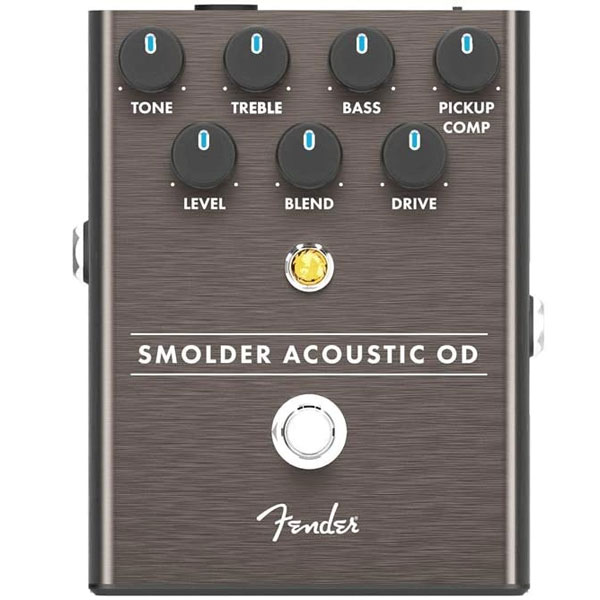
| Estimated Price | $150 |
| Type | Digital |
| Effects | Overdrive |
| Connectivity | 1 x 6.35mm Jack Input, 1 x Outputs |
| Power | 9 Volt |
My Review: After testing many devices, I came to the conclusion that adding overdrive, distortion, or any form of saturation to an acoustic guitar is notoriously difficult. I believe this is because the natural tone of the strings and the complex harmonics of the instrument mean that adding gain can result in a sonic disaster.
If anyone’s going to be willing to accept the challenge, it’s Fender. I was very excited when I saw that the legendary guitar manufacturer has recently turned their attention to producing effects pedals that are exclusively for the acoustic guitar. The Smolder is undeniably one of their finest offerings.
This incredibly detailed acoustic overdrive pedal has several innovative features. Firstly, to soften the attack of the Piezo pickup, I loved that there’s a Pickup Compensation control that reduces the highs. The Drive control gently adds saturation to the signal, and the cabinet simulation provides you with flexible tones when your amplifier isn’t satisfying your needs.
The Fender Smoulder has evolved from an all-original Fender circuit. With their unrivaled experience creating tube amplifiers, it’s no surprise that this pedal is a standout option when it comes to overdrive acoustic guitar pedals. The design of the Smoulder is likely to benefit you if you like to use different EQ settings throughout your acoustic set.
Who is this best suited for: Blues, bluegrass, country, and rock guitarists will adore the overdrive that the Smolder adds to their acoustic guitar’s signal. This pedal maintains a balanced tone while adding a layer of grit to the natural sound of the instrument.
Bottom Line: Featuring a 3-band EQ, several filter controls, onboard cab simulators, specially designed pickup compensation, and a classic overdriven tone, the Fender Smolder is one of the best acoustic guitar pedals on the market. It’s built like a tank, and very easy to operate.
10. TC Electronic MojoMojo (Overdrive Pedal)
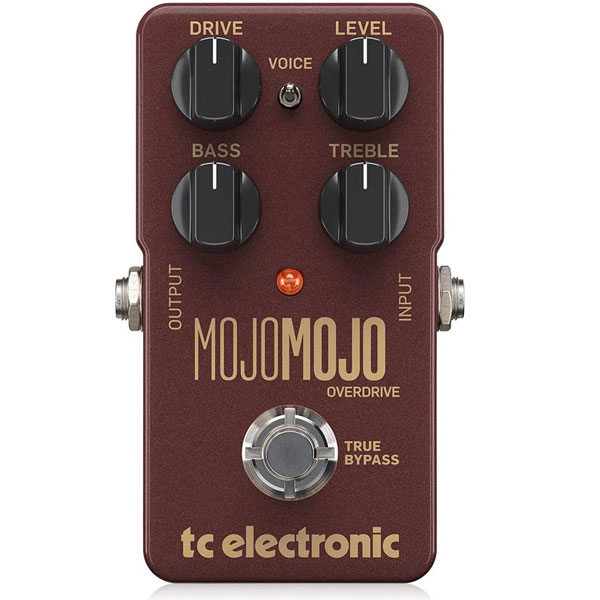
| Estimated Price | $60 |
| Type | Digital |
| Effects | Overdrive |
| Connectivity | 1 x 6.35mm Jack Input, 1 x Outputs |
| Power | 9 Volt |
My Review: When I first used the MojoMojo by TC Electronic, I was blown away. This is a detailed overdrive pedal that has all of the necessary qualities to be used with an acoustic guitar. Considering that it’s the flagship overdrive pedal of the prolific manufacturer, I found it to be very reasonably priced.
I’m a huge fan of authentic tube overdrive, so when I learned that this pedal is designed to imitate the natural saturated break-ups that are produced when a tube amplifier heats up, I was very excited to put it to the test. Impressively, I found that the MojoMojo adds warm and rich overdrive to an acoustic guitar. It naturally responds to the dynamics of your playing, to create an authentic and natural effect.
To combat the common issue of harshness when overdriving an acoustic guitar’s tone, TC Electronic has installed a 2-band EQ on the front of the pedal. This allowed me to reduce or boost the prominence of bass and treble frequencies in the output. Additionally, there’s a voice switch for instantly changing the tone of the overdrive, another tool I found to be valuable.
It took a lot of patience and analysis for TC Electronic to finally perfect the circuitry for the MojoMojo overdrive pedal. One of the key elements which makes this device highly compatible with an acoustic guitar is the increased circuit board voltage, which provides additional headroom. Compared to other overdrive pedals, it offers 3-4 times the amount of voltage, which in turn adds more energy to the output.
Who is this best suited for: I’d highly recommend the MojoMojo to any acoustic guitarist who wants to add some grit to their signal. If you’re into playing stomping blues riffs and shredding out the occasional acoustic solo, this pedal will be a great addition to your rig.
Bottom Line: TC Electronic produces a vast selection of effects pedals that cover all categories. The MojoMojo is arguably their best overdrive or distortion pedal. When paired with an acoustic guitar, it produces authentic-sounding tube distortion that is responsive to the dynamics of your playing.
11. NUX Stageman (Preamp Pedal)
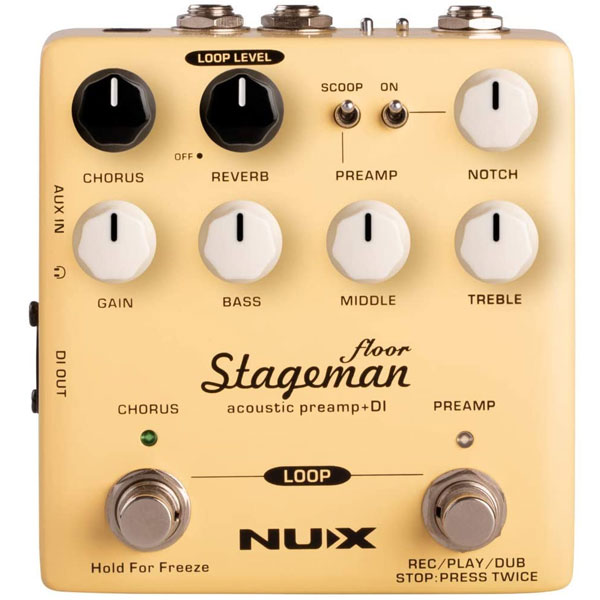
| Estimated Price | $150 |
| Type | Digital |
| Effects | Preamp |
| Connectivity | 1 x 6.35mm Jack Input, 2 x Outputs |
| Power | 9 Volt |
My Review: The Stageman by NUX is a highly useful preamp that was specifically designed to be used with an acoustic guitar. This pedal is great because it provides guitarists with complete control over every aspect of the instrument’s amplified tone, with EQ, chorus, reverb, looping, and other capabilities.
The Stageman is so extensive that I feel simply calling it a preamp doesn’t do it justice. Due to the sheer number of options it provides, one could make a strong argument that this is a multi-effects pedal!
The preamp quality was evident as soon as I plugged in my acoustic guitar. What sold me on this particular model, was how it adds a touch of coloration and compression to the tone, highlighting the sweet spots in the frequency range of the instrument. Then, I was pleased to learn that you can choose to either keep things simple or experiment with the plethora of onboard controls.
Depending on the particular pickup type that your acoustic guitar has installed, you can tailor the performance of the NUX Stageman to suit it. With a switchable pickup selector, this pedal can shift into another form to suit the specifics of your setup. This is a feature I’d be tempted to use heavily!
I discovered that as a bonus, there are several effects built into this acoustic preamp pedal. Firstly, there’s the onboard chorus and reverb, both of which are controlled using the rotary knobs on the face of the pedal. Then there’s the looper that offers up to 60 seconds of recording time, and finally, the three-band EQ allows for further adjustment of the tone of the preamp pedal.
Who is this best suited for: Acoustic guitarists of all styles should strongly consider adding a preamp pedal to their rig. The NUX Stageman acts as a central hub for controlling the foundations upon which your overall sound is built upon.
Bottom Line: It’s rare that preamp pedals also include a range of onboard effects, but NUX has proven that you can combine quantity and quality in an acoustic guitar pedal. Offering various options to ensure that the pedal suits your guitar and playing style, the Stageman is a comprehensive preamp pedal that will transform your tone for the better.
12. BOSS AD-2 (Preamp Pedal)
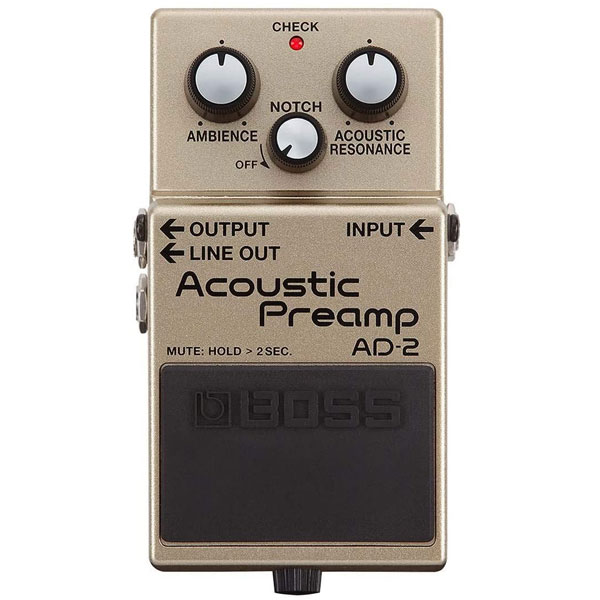
| Estimated Price | $100 |
| Type | Digital |
| Effects | Preamp |
| Connectivity | 1 x 6.35mm Jack Input, 2 x Outputs |
| Power | 9 Volt |
My Review: Although BOSS is best known for its electric guitar pedals, I was excited to try their AD-2, which is specifically formulated for the acoustic guitar. Drawing on their decades of experience in producing high-quality stompboxes, my first impression was that BOSS has created a fabulous mini preamp pedal.
Designed to optimize the sound of an acoustic guitar before it reaches the stage monitors or the amplifier, the AD-2 features several controls to provide us with more sonic freedom. Here at Guitar Lobby, we were particularly fond of the Notch filter, which is highly effective at controlling feedback, even when using a magnetic pickup.
My experience in the field of effects pedals has shown me that one of the qualities that are often associated with BOSS pedals is their exceptional durability. Right off the bat, I could tell that the AD-2 is built to last, with a solid metal chassis and a robust stompbox design. It also includes an Ambience knob and Acoustic Resonance control for making further tonal adjustments.
What sets this pedal apart from other similar devices is its exceptional ability to produce a natural acoustic tone while increasing the character of the instrument’s amplified signal. It’s particularly useful for bypassing an amplifier and sending the output directly into a PA system or DI box, so if you’re looking for a mobile option, this is one of the best preamps out there.
Who is this best suited for: Touring acoustic guitarists, or those who are likely to use their pedals extensively will enjoy the unrivaled durability of the BOSS AD-2 Acoustic Preamp pedal. It’s a great addition to any guitarist’s pedalboard.
Bottom Line: Housed in the iconic BOSS Stompbox chassis, the AD-2 offers three useful controls for tailoring the sound of your acoustic guitar. The Ambience, Notch, and Acoustic Resonance control all make it much easier to get the exact amplified tone that you’re looking for.
13. L.R Baggs Align Acoustic Equalizer (EQ Pedal)
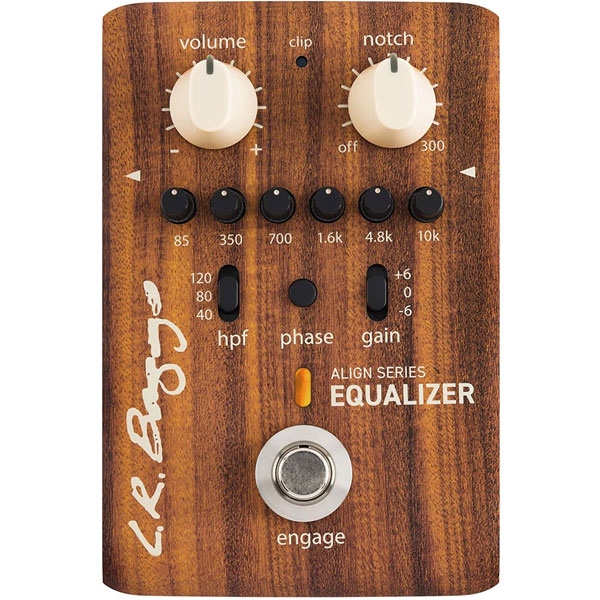
| Estimated Price | $180 |
| Type | Digital |
| Effects | EQ |
| Connectivity | 1 x 6.35mm Jack Input, 1 x Outputs |
| Power | 9 Volt |
My Review: L.R Baggs returns to this definitive list of the best acoustic guitar pedals, with their elegant Align Equalizer. Designed especially for the acoustic guitar, I was intrigued by the way that this pedal deviates from the stereotypical style that you’d expect from most EQ devices.
After researching the heritage of the device, I learned that it was inspired by the popular Para Acoustic DI pedal. The Align Equalizer uses a high-graded FET gain stage and combines it with tone-shaping EQ that provides musicians with complete control over the frequency output of their acoustic guitar.
Offering 6-bands of EQ, this pedal also has a variable high pass filter that tames any wild low-frequencies. It took a little while for me to get the hang of the phase inversion control, but when I did, I found it to be a useful tool designed to combat feedback and signal loss. To top it off, there’s also a three-position switch on each frequency band.
The Para Acoustic DI has coined a reputation as one of the best direct input devices of its time. This device is intrinsically linked to the Align Series Equalizer, with LR Baggs using its circuitry to inspire the impeccable electronics housed within their pedal. By using this pedal, I believe you’ll gain added flexibility for tailoring the frequency output of an amplifier acoustic guitar.
Who is this best suited for: The L.R Baggs Align Equalizer is suitable for any acoustic guitarist who cares about the overall tone of their instrument. Not only does it allows you to add or remove particular frequency bands from the output, but it also has several controls specifically for common issues posed by amplifying acoustic guitars with pickups.
Bottom Line: This detailed EQ pedal continues the impressive Align line by L.R Baggs. It goes above and beyond what you’d expect from a basic guitar EQ pedal, allowing you to control the phase inversion and gain of your guitar’s signal. What’s more, it also tames any unwanted feedback using the Garrett Null notch filter.
14. JOYO R-12 (EQ Pedal)
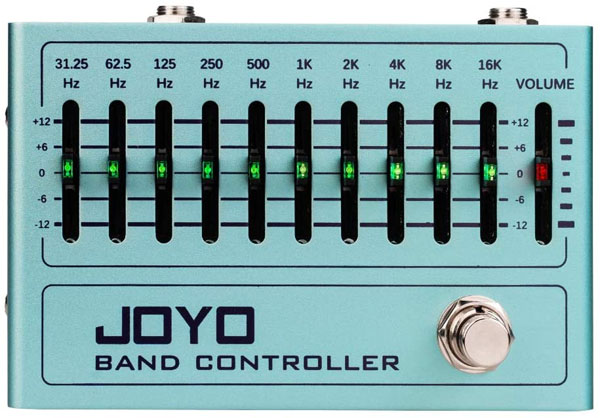
| Estimated Price | $90 |
| Type | Analog |
| Effects | Chorus |
| Connectivity | 1 x 6.35mm Jack Input, 1 x Outputs |
| Power | 9 Volt |
My Review: In recent years, JOYO has established its reputation as a leading producer of high-quality, low-price effects pedals. The majority of their devices I’ve tested are aimed at electric guitarists, but I was impressed to find that the R-12 EQ pedal is equally compatible with an acoustic guitar.
With 10 frequency bands, the R-12 can be used to shape the tone of an acoustic guitar meticulously. Instantly, I could tell that this pedal was extensive and detailed. The frequency range spans from the lowest bass note to the highest harmonics of the instrument, so it’s possible to tweak every aspect of the output.
If you’re a little obsessive over your tone as I am, you’ll love this feature. It’s also fitted with a master volume control, true bypass switching, and is housed in a sturdy metal chassis with a retro design. The interactive slider layout of the pedal is in my opinion, what sets it apart from its competitors.
Who is this best suited for: If you’re looking for a capable EQ pedal for your acoustic guitar, but don’t want to spend a small fortune, the JOYO R-12 is worthy of consideration. This pedal is very easy to use and doesn’t require any previous experience with equalization of effects pedals in general.
Bottom Line: Affordable and effective, the R-12 allows you to have absolute control over each frequency band of your acoustic guitar. The pedal is simplistic and reliable, with clearly displayed graphic EQ and sensitive sliders for making adjustments as you please.
15. Zoom A1 Four (Looper Pedal)
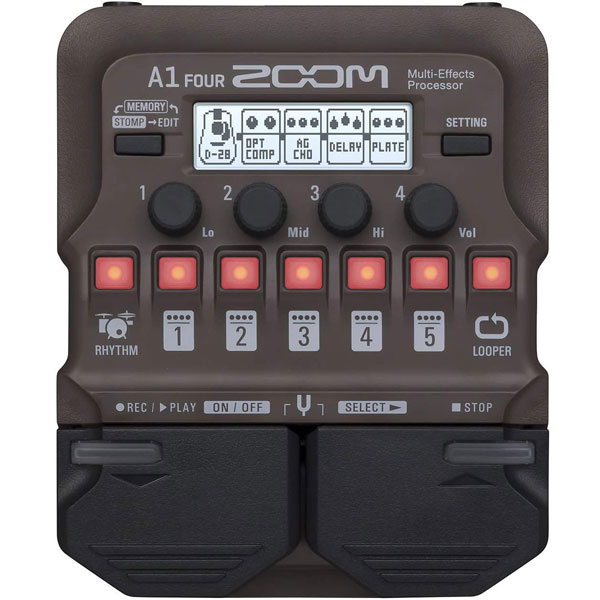
| Estimated Price | $130 |
| Type | Digital |
| Effects | Looper |
| Connectivity | 1 x 6.35mm Jack Input, 1 x Outputs |
| Power | 9 Volt |
My Review: As someone with a fair amount of experience using loop pedals, I was excited to test the Zoom A1 Four. It features a range of specially engineered effects, most notably a highly functional looper. This digital pedal is designed for acoustic instruments, which is music to my ears, as most looper pedals seem to be geared towards the electric guitar.
With interactive controls and over 80 preloaded effects, I can’t deny that this Zoom acoustic looper pedal is a wonderful tool. If found that you can use it either to shape the tone of your acoustic guitar, or simply to create loops, adding percussion using the onboard drum machine, and processing your recordings using the plethora of onboard effects.
The process of creating the A1 Four involved a lot of trial and error from Zoom. They first began by using blueprints from standalone effects designed for electric guitar, then the device slowly evolved into an acoustic-specific multi-FX unit. I think you’ll be blown away by the sheer volume of processing tools offered by this wonderful, unique device.
Who is this best suited for: If you’re a solo artist who needs to add another dimension to their performances, the Zoom A1 Four is perhaps the best pedal you could purchase. It’s a highly capable looper pedal, but also offers a vast range of other processing options to take your live shows to a whole other level.
Bottom Line: The A1 Four by Zoom is one of the most extensive acoustic guitar pedals on the market. Its main function is a looper, offering up to 30 seconds of looping time at pristine audio quality. However, its capabilities don’t stop there. The pedal also has 60 inbuilt rhythm sections, 50 user preset slots, and effects specifically for other acoustic instruments like saxophone, harmonica, and violin.
16. ISET Looper Pro (Looper Pedal)
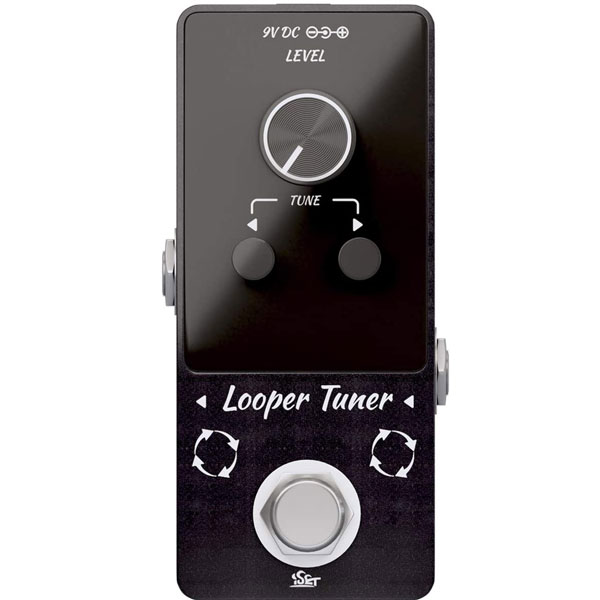
| Estimated Price | $50 |
| Type | Analog |
| Effects | Looper |
| Connectivity | 1 x 6.35mm Jack Input, 1 x Outputs |
| Power | 9 Volt |
My Review: ISET’s Looper Pro pedal stood out to me as an affordable option for acoustic guitarists who want to create their own backing tracks. I found it to be very simple to operate and was encouraged to find that it also doubles up as a tuner pedal for added convenience.
The pedal includes a total of 9 loop channels, with an impressive 10 minutes of single loop recording time. There is a visible display screen that indicates the length of the loop you are currently recording. Then, I found that there is also the useful feature of USB compatibility so that you can upload your loops to a computer or laptop for further processing.
When putting the ISET Looper to the test, we found that the main quality which separates it from standard acoustic guitar loopers is its lossless, uncompressed tone. This is due to the improved sample rate and the quality of the pedal’s inner circuitry. It will allow you to create long loops of high-quality audio with your acoustic guitar.
Who is this best suited for: At first glance, the ISET Looper Pro pedal looks quite simplistic. It is indeed very easy to operate, but it also offers a range of impressive functions. For this reason, I’d recommend it to any solo acoustic guitar player looking to add new sonic dimensions to their performances, or looking for a way to create backing tracks to jam over.
Bottom Line: A looper and tuner pedal built into one, the ISET Looper Pro is a high-performing option for acoustic guitarists. It offers a huge 40 minutes of total looping time, with 9 independent channels for stacking laters on top of each other. You can also upload your jams to a computer as WAV formats using the USB connector.
17. BOSS ME-80 (Multi-Effects Pedal)
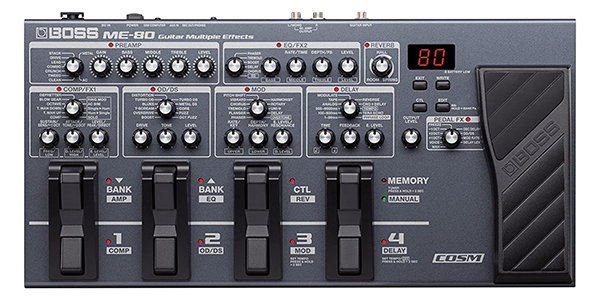
| Estimated Price | $300 |
| Type | Digital |
| Effects | Multi-FX |
| Connectivity | 2 x 6.35mm Jack Input, 2 x Outputs |
| Power | 9 Volt |
My Review: Although I’m aware that saving the best until last is clichéd, to say the least, it could well be true in this case. The BOSS ME-80 is the ultimate all-in-one controller for your acoustic guitar. I found it to be so detailed that it almost removes the need for any other pedals at all!
Where do I start? The ME-80 includes an incredible amount of effects and processing options. The effects are broken up into eight categories, and they range from classic BOSS creations to state of the art MDP effects. There’s an onboard looper with 38 seconds of recording, a built-in USB audio interface for direct recording into your DAW, and a massive range of amp simulators.
It’s fair to say that the ME-80 evolved from BOSS’ many decades producing singular guitar effects. With each pedal they’ve perfected, they added a new section to this multi-effects unit, resulting in it being one of the most detailed options on the market for acoustic guitarists to enjoy.
Who is this best suited for: I prefer to have a range of separate effects pedals in my signal chain. However, you might be the type of acoustic guitarist who likes to keep everything in one place. If that’s the case, then the BOSS ME-80 is the ideal pedal for you.
Bottom Line: With a highly powerful digital processor, hundreds of onboard effects, looper capabilities, and much more, the ME-80 is one of BOSS’s finest creations. It’s the perfect device for controlling every aspect of your acoustic guitar’s amplified tone.
The Ultimate Acoustic Guitar Pedal Guide
Electric guitars are more commonly associated with effects pedals than their acoustic counterparts. Historically, pedals have been used to sculpt the tone of an electric guitar, transforming its sound completely.
Despite the unquestionable compatibility of electric guitars with effects, acoustic guitars also benefit from being a diverse pedalboard. Providing the acoustic guitar has an onboard pickup, you can use effects pedals to create innovative and original tones.
Many of the effects pedals that sound great when used with an electric guitar, also produce interesting results with an acoustic guitar. However, due to the varied timbre and tone of acoustic instruments, the results can be completely different.
In the remainder of the guide, I’ll provide you with an in-depth analysis of acoustic guitars and effects pedals. If you’re still a little unsure of which pedals to go for, your questions will be answered in the following sections.
Common Acoustic Guitar Effects
Acoustic guitar pedals can be broken down into four categories. These are:
- Dynamic Pedals
- Gain-Boosting Pedals
- Modulation Pedals
- Reverb and Delay Pedals
Each type of acoustic guitar pedal causes alterations to the audio signal. The method used to interact with the clean signal of the acoustic guitar determines the impact the pedal has on the instrument’s tone. Some effects are significantly more prominent and extreme, compared to others which have a more subtle impact.
Dynamic Pedals
Acoustic guitar pedals that fall into the “dynamic” category include:
- Compressors
- Equalizers
- Noise Gates
- Limiters
Compressors are particularly useful for acoustic guitar because they help to create consistent volume levels by raising or limiting sounds that exceed a set threshold. This ensures that all of the notes played on the acoustic guitar can be heard and that any overly loud tones are limited for consistency.
EQ is also a highly useful type of acoustic guitar pedal. They are used to increase or decrease the presence of particular frequency bands produced by the instrument. For example, if the tone of your amplified acoustic guitar sounding too bass-heavy, you could use the EQ pedal to reduce the volume of the 200-400Hz frequency range. Likewise, you reduce high-end frequencies if the tone was too harsh-sounding.
Gain-Boosting Pedals
Commonly used with electric guitars, gain-boosing pedals are great for adding character to your tone. They also produce interesting sounds when combined with an acoustic guitar. These effects include:
- Distortion
- Overdrive
- Fuzz
Overdrive is a great type of effect pedals to combine with an acoustic guitar, especially for producing bluesy, saturated riffs. Fuzz is less commonly used with acoustic instruments, due to the intense transformation it causes to the natural tone. Adding a touch of distortion to an acoustic guitar is a great way to draw attention to a riff or solo.
Modulation Pedals
The category of modulation effects includes a wide range of pedals that are highly compatible with an acoustic guitar. Some of the main modulation pedals are:
- Chorus
- Phasers
- Flangers
- Pitch-shifting
- Octave-shifting
- Vibrato
- Tremolo
One modulation-based effect that blends wonderfully with the natural tone of an acoustic guitar is chorus. These pedals work by duplicating the clean signal, then playing back the second version with slight delays of timing and fluctuations in pitch. The result is a warm, warbly tone that can bring a chord sequence to life.
Phasers and flangers work similarly to chorus pedals, creating a carbon copy of the original signal then modulating it. Instead of simply delaying the timing or altering the tuning of the duplicated signal, these pedals use LFOs (Low-Frequency-Oscillators) to layer the acoustic guitar’s tone with non-harmonically related notch filters.
Reverb and Delay Pedals
Two of the effects that are the most compatible with the acoustic guitar are reverb and delay. There are several high-quality pedals specifically designed for acoustic guitar, which feature these effects. It’s common to find reverb and delay combined within the same acoustic guitar pedal.
Reverb pedals recreate the natural effect of soundwaves coming into contact with a surface, by simulating the acoustic qualities of different locations. You can add hall reverb, cathedral reverb, spring reverb, plate reverb, chamber reverb, and more to your acoustic guitar.
Delay pedals create a second audio signal that is played at varying time-spaces after the original. The span of tones that can be produced using a delay pedal with an acoustic guitar is almost limitless. You can add tight double-track delay, or create ambient soundscapes of never-ending decays.
Signal Chain Placement
If your pedalboard consists of more than one effect, you technically have created a signal chain. One of the most important considerations an acoustic guitarist will make once they amass a small collection of pedals is how to position them in the signal chain to get the best results.
Let me start by pointing out that pedal positioning, like all music-related topics, is a subjective matter that varies depending on the personal taste of every musician. Many of the guitar tones that are now considered to be iconic, were first discovered as a result of going against the grain. That is to say, take this advice with a grain of salt, and feel free to experiment to find tones that are interesting to you!
Nonetheless, there is a conventional set of rules that are generally accepted amongst guitarists when assembling your signal chain. Following this order will provide you with the cleanest-sounding, most efficient pedalboard possible. I’d recommend following this advice initially, then swapping some of the pedals around to find out what impact the varied orders have on your acoustic guitar’s tone.
The suggested order of acoustic guitar pedals is as follows: firstly, you begin with a tuner pedal. This is because you need the cleanest signal of your acoustic guitar to enter the tuner so that the effects don’t mess with the pedal’s ability to assess the instrument’s tuning.
Then comes any pedals that are used to control dynamics. This includes compressors, EQ, noise gates, and limiters. Volume pedals also are commonly positioned at the beginning of the signal chain. Next come distortion, overdrive, and fuzz. These three pedals increase the gain of your signal, and they are followed by modulation pedals like chorus, phasers, flangers, octave pedals, and so on.
Finally, after modulation pedals, the signal chain is completed by reverbs and delays. The reason that these pedals are positioned at the end of the signal chain, is because they cause drastic alterations to the acoustic guitar’s tone, and if they are placed before other effects, things can get a little messy!
Powering Your Acoustic Guitar Pedals
When your acoustic guitar pedal collection becomes more extensive, you’ll need to consider the most efficient and practical way to provide power the all of the effects. The best way to do this is by purchasing a PSU (Power Supply Unit).
Power supply units have multiple outputs, which connect to your acoustic guitar pedals using a small power cable. They vary in terms of the number of outputs they provide, the voltages of their outputs, and also their size.
If you’re slowly building up your acoustic guitar pedal collection, and you will likely be purchasing more in the future, it might be a good idea to invest in a power supply that has more outputs than you currently need. This will prevent you from having to purchase another power supply in the future to facilitate your expanding effects chain.
The vast majority of acoustic guitar pedals are powered by 9 volts DC. However, you might find that larger pedals with onboard digital processers may require larger voltages, such as 12v, 18v, or even 24v DC. For the most part, pedals that run off 9 volts can also be powered by a single battery.
Powering your pedals using 9-volt batteries is great if you’re playing a show where mains power is difficult to come by. Nevertheless, it’s not a method that you should rely on consistently, for a couple of reasons. Firstly, you’ll probably end up spending the same amount of money purchasing batteries for your acoustic guitar pedals, as you would have spent on a power supply, in the long run.
Secondly, batteries are unreliable. If one of your pedals suddenly cuts out onstage due to a dead battery, this can completely ruin the performance. As a result, I’d recommend using both batteries and a power supply unit, so that if one power source malfunctions, the other is there to pick up the burden, and the performance, rehearsal, or recording will not be ruined!
Cables & Pedalboards
Acoustic guitar pedals require certain cables to work. Without the correct cables, you will be unable to produce any sound from the combination of your acoustic guitar and your pedals. Firstly, to connect the pedals to the power supply, you’ll need several power cables. Typically, pedals use 2.1mm patch cables to connect to the power supply.
Likewise, you’ll need a selection of patch cables to connect one pedal to the other. Although all patch cables essentially perform the same function, there is a diverse range of quality depending on the specific brand you choose. It’s always worth investing a little extra in cables because it’s likely to save you time, effort, and money further down the line.
Finally, you’ll need 6.35mm jack cables to connect your acoustic guitar’s pickup input to your amplifier. Again, I’m a big believer in choosing high-end cables, as there’s nothing more frustrating than the dreaded crackle or cut-out caused by a faulty guitar cable when you’re performing or recording.
Pickups & Acoustic Guitar Pedals
Acoustic guitar pickups are different from those installed in electric instruments, but they perform the same role. The pickups take the sound of the acoustic guitar and convert it into a signal that is capable of being amplified. Due to the dynamic tone of an unplugged acoustic guitar, the overall sound is less dependent on the choice of pickup than it is with an electric guitar.
There are three main types of pickups used with acoustic guitars. These are:
- Magnetic
- Piezo
- Microphone
Each of these pickup types has various benefits and drawbacks. They all have a distinct character and the way they operate also varies. If your acoustic guitar already has a pickup installed and you’re pleased with how it sounds, you can skip this section. If you need to install a pickup to use pedals with your acoustic guitar, or you’re simply not satisfied with the tone of your current pickup, the following information will be helpful.
Magnetic Pickups
Magnetic soundhole pickups are commonly paired with acoustic guitars due to the relatively clean and accurate sound they produce. These pickups work by wrapping a magnet with insulated copper wire, which results in a magnetic field is created. This magnetic field is then altered by the vibration of the guitar string, in the same way as an electric guitar pickup works.
Tonally, magnetic soundhole pickups are warm and musical by nature. They also hone in on the small details of the strings and are therefore preferred by acoustic guitarists who play technically and intricately.
The main advantage of using soundhole magnetic pickups is that they provide a desirable amount of sonic warmth, especially when compared to a piezo pickup. They’re also easy to integrate with acoustic guitar effects, and installing them is as simple as tightening a couple of screws.
The only disadvantage of magnetic soundhole pickups is that they aren’t particularly effective at capturing the natural acoustic resonance of the guitar’s inner body. Also, these pickups are prone to feedback issues when played at high volumes, and they’re incompatible with nylon-string guitars.
Piezo Pickups
Piezo pickups, also commonly called transducer pickups, work by converting vibrations into an electric signal which is then amplified. The Piezo system is installed between the bridge and its saddle, where the vibrations from the strings cause changes in air pressure and therefore alter the electrical voltage of the piezoelectric mechanism.
Sonically, Piezo and other transducer pickups end to produce a direct tone, with a sharp attack. Much like magnetic soundhole pickups, they don’t amplify the natural resonance of the acoustic guitar’s body because they convert vibrations into an electrical signal. Piezo pickups have a bright tone, especially when positioned under the saddle.
Transducer and Piezo pickups are considered to be more reliable than their soundhole equivalents. This is because their tone is easier to tame, and they are much less likely to fall victim to feedback issues. They’re also brilliant at amplifying nylon-stringed guitars as they don’t rely on a magnetic field.
The drawback of Piezo pickups is that many acoustic guitarists consider their tone to be unnatural sounding. There is a term known as the “Piezo-quack” which describes an undesirable;e harsh tone that commonly occurs when using this style of pickup.
They are compatible with acoustic guitar pedals but don’t lend themselves to that purpose as effectively as the aforementioned magnetic soundhole pickups do.
Microphone Pickups
The third type of acoustic guitar pickup, and perhaps the least compatible with effects pedals, is the microphone variety. As the name suggests, these pickups consist of a small microphone that is placed inside the soundhole of an acoustic guitar.
The benefit of using this style of pickup is that it successfully captures the resonance inside the guitar’s body, thus creating n natural tone that is rich with harmonics and acoustic warmth. However, microphones are prone to feedback, which causes issues if you pair this type of pickup with an acoustic guitar pedal that increases gain or volume.
Final Thoughts
Hopefully, you’ve found the acoustic guitar pedals that you’ve been looking for in this guide. Now you can enjoy the new sonic possibilities that your acquisitions provide!

My name is Chris and I’ve had a passion for music and guitars for as long as I can remember. I started this website with some of my friends who are musicians, music teachers, gear heads, and music enthusiasts so we could provide high-quality guitar and music-related content.
I’ve been playing guitar since I was 13 years old and am an avid collector. Amps, pedals, guitars, bass, drums, microphones, studio, and recording gear, I love it all.
I was born and raised in Western Pennsylvania. My background is in Electrical Engineering, earning a Bachelor’s degree from Youngstown State University. With my engineering experience, I’ve developed as a designer of guitar amplifiers and effects. A true passion of mine, I’ve designed, built, and repaired a wide range of guitar amps and electronics. Here at the Guitar Lobby, our aim is to share our passion for Music and gear with the rest of the music community.
